This post may contain affiliate links. Please read our disclosure policy.
This Lebanese Kaak recipe is for the traditional soft, sweet, anise-scented sweet bread-like treat that is molded or pricked on top for a design. There are many other versions of kaak, including crunchy biscuits and sesame-coated purse bread.
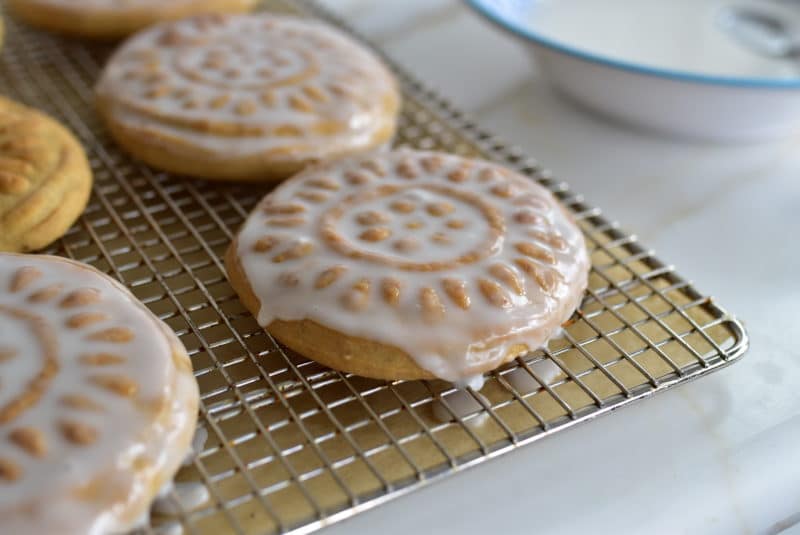
Here is a tried and true recipe, a kaak recipe that made Aunt Louise famous (yes, I still call my mother-in-law “Aunt.”) for baking the finest, buttery sweet bread known to humankind.
And here, I humbly submit, I have been working in the lab that is my kitchen to enhance her already-perfect recipe.
Before the heavy hand of the Lord comes down upon me for my sacrilege, let me just say that I believe even this beautiful second mother of mine (who gets to have TWO beautiful mothers in their lives? My blessing is beyond!) would say that her ka’ik dough can be so darn finicky. I remember days when we’d stop over and Aunt Louise would be shaking her head over a batch of ka’ik, muttering “it didn’t rise . . . it didn’t rise.” Which was a total affront, given the warm blankets she laid out on the counter both under and over her dough.
Here’s how we’re going to make the finest ka’ik of all time, starting at the beginning:
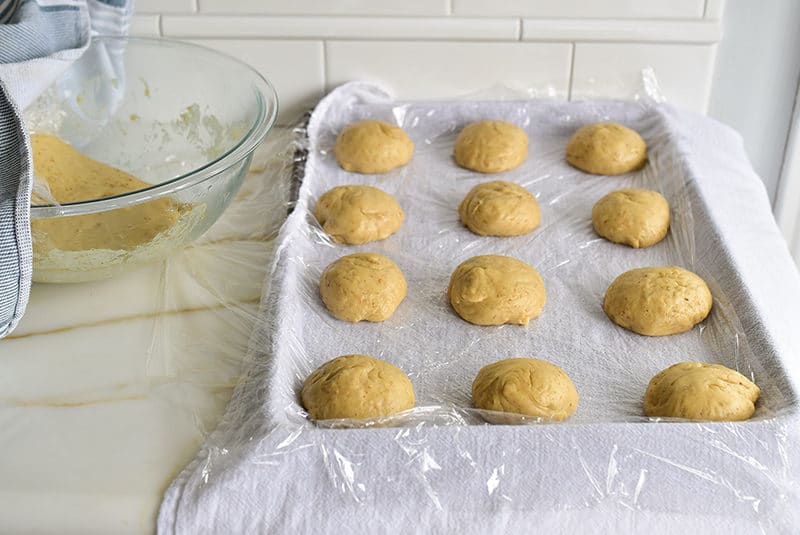
What is Lebanese Kaak?
I’ve shared with you before some of the confounding aspects of our beloved Lebanese ka’ak (also called ka’ik and kak).
I have asked (and continue to ask): is ka’ak a Lebanese bread, a yeasted donut? Or a cookie?
Ka’ak is both; ka’ak is all! Crunchy biscuit in a ring shape. Shortbread Cookie (my own invention…). Soft, buttery sweet bread. And Lebanese purse bread, a handbag-like shape of sesame-coated pocket bread with hole for hanging on a hook sold by Lebanese street vendors, often filled with knafeh (my Lord, the Lebanese are a brilliant people).
Here our attention is on the soft, buttery sweet bread. The recipe that I rely on, as do many throughout the land if I dare say it, is handed down from my Danny’s mom and matriarch, Louise (a.k.a. “Aunt Louise”).
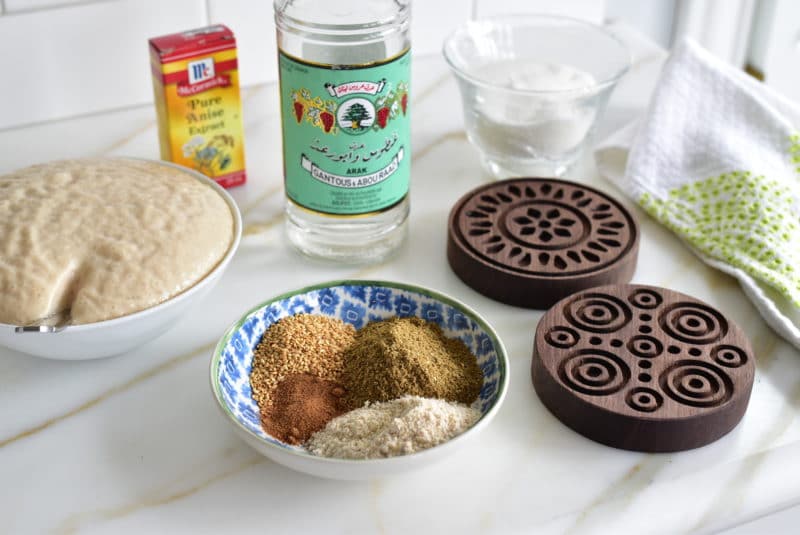
Ingredients to Make Kaak
I’ve made batch upon batch to confirm findings, to which Dan and Steven will attest: Bingo! Steven has said in hushed tones over the years, I’ve got to say, I don’t go crazy for the Easter cookies. But the new and improved kaak? he took a little baggie of them home with him for second supper (more on that another time). My brother Richard, the most discerning eater I know, dubbed the new kaak “so soft and sweet like a donut.” Enough said.
For the dough:
Rapid rise or instant yeast, also known as bread machine yeast
Granulated sugar
Clarified butter, which is butter ghee — butter with the fat solids removed
Whole milk, to enrich
Unbleached all-purpose flour. I prefer it to bread flour for a softer result
Mahleb, a Middle Eastern spice made from cherry pits, the kernel of the St. Lucie cherry. Find the freshest mahleb on the market in my shop!
Anise seeds, for that essential black licorice anise flavor
Anise extract, Arak, or Ouzo, to double down on the anise flavor
Nutmeg, toasted sesame seeds, and salt
Olive oil, simply for coating the bowl
For the glaze:
Confectioners’ sugar
Pure rose water plus a little tap water
Corn syrup. Don’t fret! This is cooking corn syrup, not the industrial we avoid on nutrition labels, and gives gloss to the glaze
How to make Kaak
Tips for making the dough:
Ka’ik dough is a yeasted dough enriched with butter and milk and sugar. All of these ingredients actually inhibit the yeast’s ability to rise (the yeast in effect crashes drunk and tired on all of that fat and sugar, same way we can).
Answer: Rapid Rise yeast and more of it, longer rise-time, indispensable warm rising environment. Alternatively, the dough rises beautifully overnight in the refrigerator, in which case, cut back in ½ tablespoon of the new yeast quantity. I love the overnight rise because it allows for freshly baked ka’ik in the morning, and there is nothing like ka’ik fresh, and now even softer with my enhancements.
For the second rise, uncover the dough for the last 15 minutes or so of the rise. The slightly dry dough makes a better imprint in the mold. This enhanced dough overall is softer, so a bit of flour on the molds and dough helps release the dough from the mold.
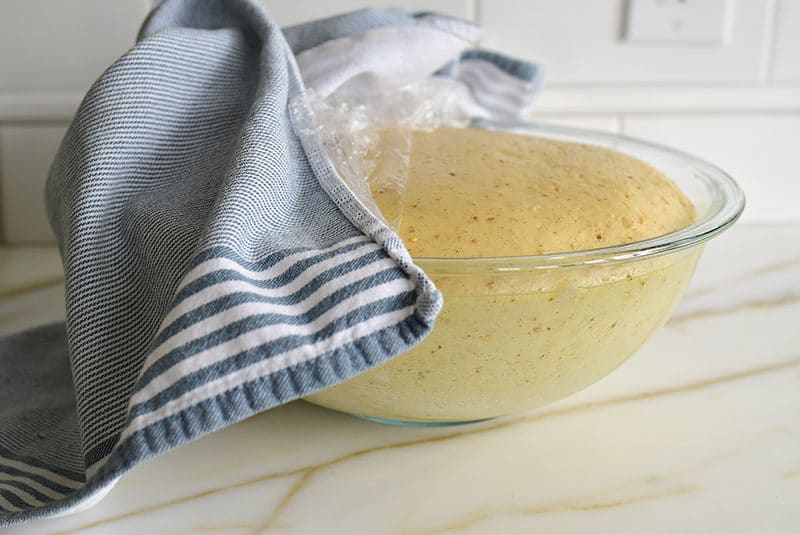
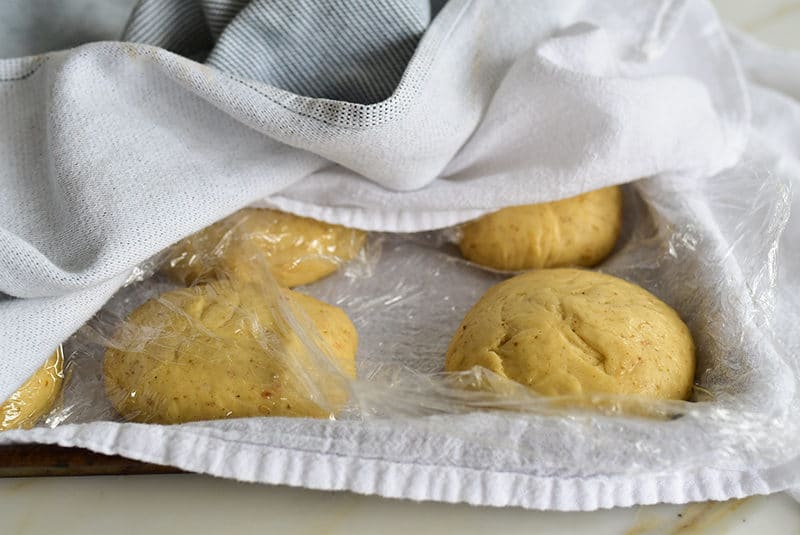
Tips for enhancing the flavors
I have doubled, even tripled the anise here and Dan still says, “did you add more anise?” I’ll thank my own mom, whose devotion to licorice flavor is stellar, for the little bottle of Pure Anise Extract I found in her spice drawer recently. Add this to the mix along with freshly ground anise, and the kaik flavor boost is perfect. Now, Mom’s is one oooooold bottle of anise extract, from a time when you could find anise extract in the grocery aisle. Not so today. So if you don’t want to wait to order your anise extract online, grab a bottle of Arak or Ouzo, which work equally as well for added anise flavor.
The mahleb, the ground kernel of the St. Lucy cherry pit, is our little kernel of sweet, aromatic almond-like flavor. This flavor is double-worthy. Note that the mahleb must be fresh; mahleb goes rancid in about a nano-second (which is why I offer fresh, fabulous mahleb in my shop!), so check the date on yours and check the aroma. If it smells rancid or “off,” you can replace the mahleb for 1/8 teaspoon almond extract.
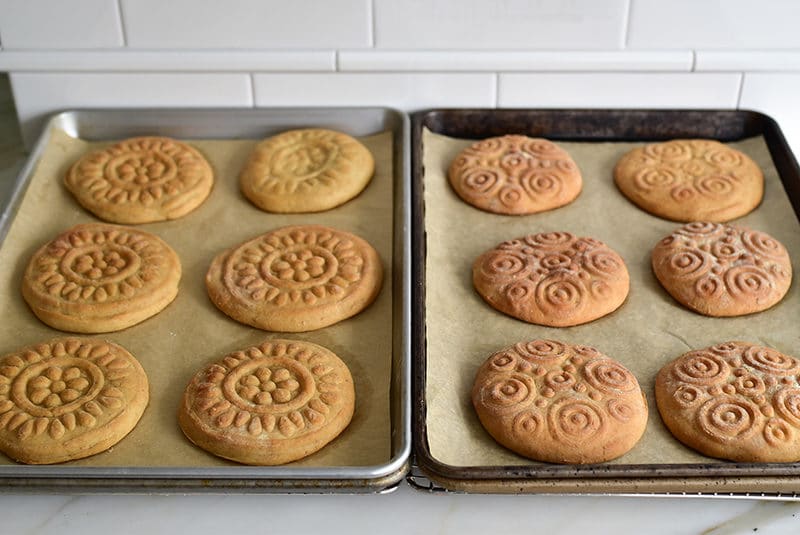
Tips for shaping kaak
Ka’ik is traditionally pressed into molds, which results in lovely imprints atop the cookies.
Back in the day, the designs were often made without molds, using a feather tip, skewer, or fork to prick a unique design in the top of each cookie.
Any method is fine! Know that the imprint can bake out of the top of the cookie, so the more the design is pressed heavily into the dough, the better.
The end of the second rise of the dough balls is done uncovered, to assist with drying out the top of the dough for molding.
With a mold, always coat the mold with flour and knock out the excess before molding each cookie. As with a baking pan for a cake, the flour assists in an easier release and prevents sticking.
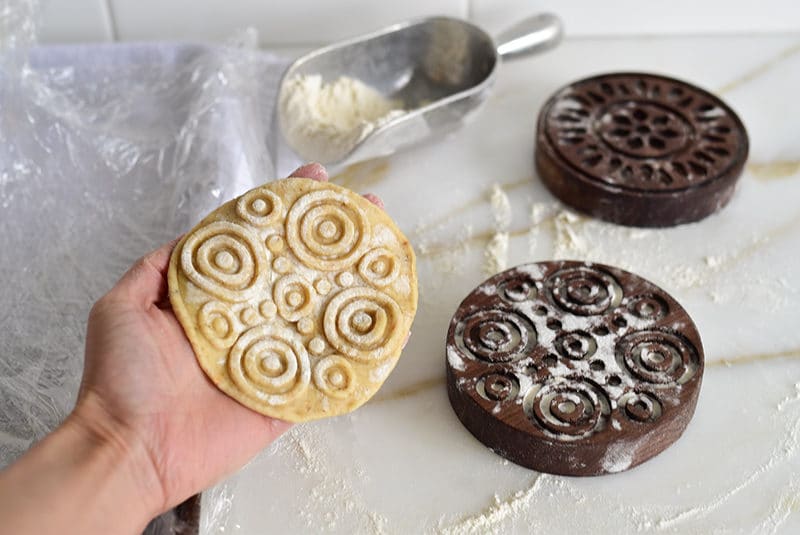
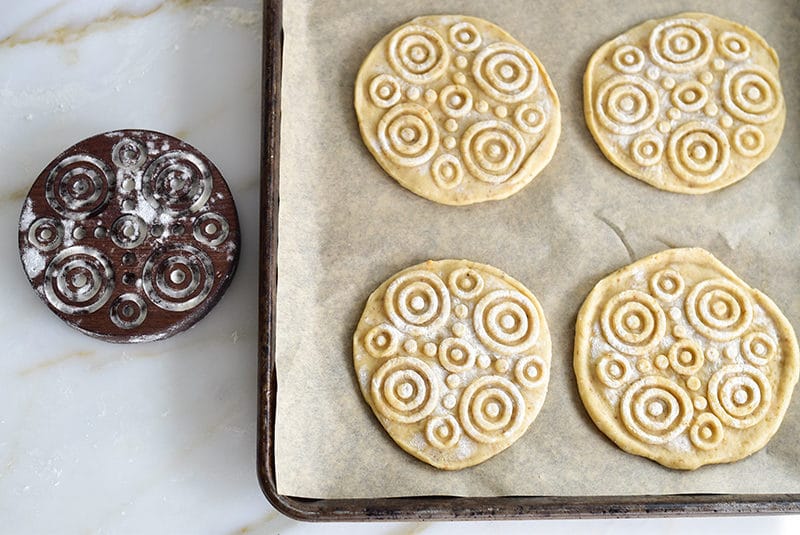
Tips for the glaze
My initial glaze experiments were primarily about simply adding sweetness to the ka’ik, until cousin Celine mentioned wanting a glaze that hardens a bit, for the ability to stack the ka’ik.
I’ve tested everything from simple syrup glazes to royal icing, and I’ve landed on a confectioners’ sugar glaze, full of rose water aroma (but not overpowering in any way), that shines and hardens to a perfect Easter-joy level. The key here is adding a touch of corn syrup, which rest assured, in home cooking is not the bad-boy high-fructose corn syrup. Still, even with the harder glaze, take care when stacking the cookies; the glazed top is still delicate and requires a layer of wax paper between.
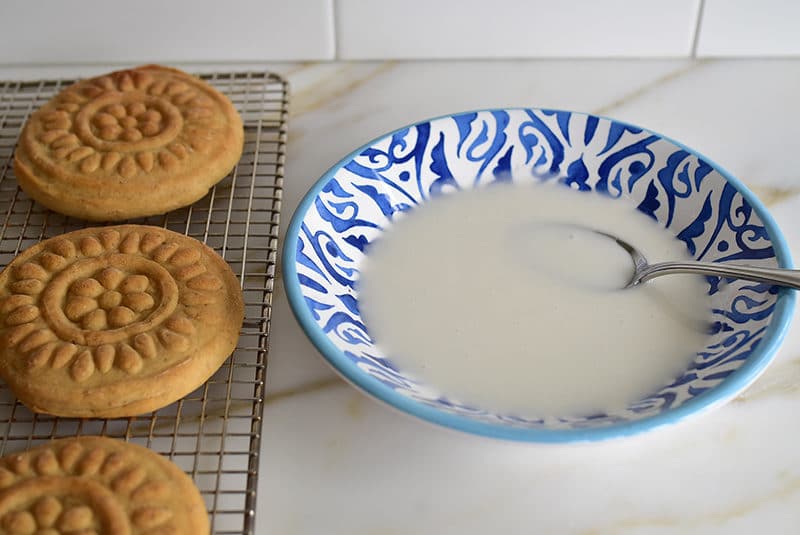
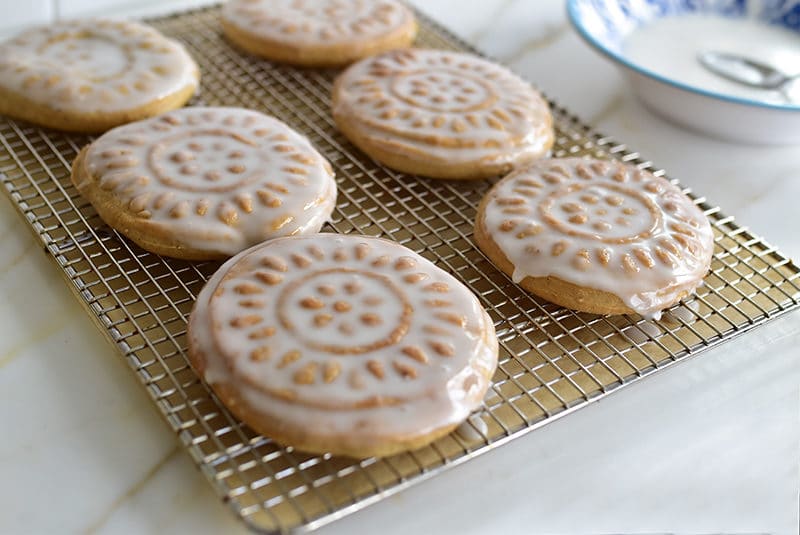
How to Store Kaak
Kaik should be stored in airtight bags or containers. The cookies will stay delicious and soft for several days. Freeze the cookies for several months. If freezing, it is best to glaze the cookies just before serving; freeze them without the glaze.
Frequently Asked Questions
Yes, this cookie takes some time with the long rises. It’s best to make them a couple of days in advance. Ka’ik can also be made weeks or months ahead. Bake the cookies, then freeze them once cooled. Thaw at room temperature and then glaze several hours or a day in advance of serving.
Substitute the anise with another extract of a flavor you like! Try vanilla or coconut. This will replace the anise extract. Replace the anise seed with more flour.
Sure can! Use a skewer, toothpick, fork, or anything pointy to make a design, deeply, on top of the cookie before baking.
More Lebanese Baking Recipes to Try
Bake a glorious Lebanese Baklawa with my easy method (truly!).
Transform the flavor of ka’ik into Kaik Shortbread Cookies, which have wonderful shortbread texture.
One of the most iconic cookies in Lebanese baking are Lebanese Butter Cookies, or Graybeh. These are shortbread cookies that melt in your mouth.
Try my knafeh recipe for another iconic Lebanese pastry, with shredded phyllo, orange blossom syrup, and a melty cheese filling.
In this recipe:
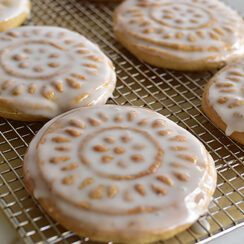
Lebanese Kaak Recipe
Ingredients
For the dough:
- 3/4 cup clarified butter
- 1 2/3 cups whole milk
- 2 tablespoons rapid rise or instant yeast
- 1 cup granulated sugar
- 5 1/2 cups unbleached all-purpose flour, plus more for dusting molds
- 2 tablespoons ground mahleb
- 1/4 cup ground anise seed
- 2 tablespoons anise extract, Arak, or Ouzo
- 1/2 teaspoon ground nutmeg
- 1 tablespoon sesame seeds
- 1/4 teaspoon kosher salt
- 1 teaspoon olive oil, to coat the bowl
For the glaze:
- 3 cups confectioners’ sugar, sifted
- 2 teaspoons rose water
- 4-5 tablespoons water
- 2 tablespoons corn syrup
Instructions
- Warm the clarified butter and milk in a small saucepan over low heat or in the microwave just until the butter is melted (not to exceed 115°F). Add the yeast and stir to dissolve.
- In the bowl of a stand mixer fitted with the hook attachment, or by hand in a large bowl, combine the sugar, flour, mahleb, anise, arak, nutmeg, sesame seeds, and salt. Slowly add the butter mixture and mix on low speed or by hand until a cohesive dough forms. Increase the speed on the mixer to knead the dough for five minutes, or by hand on the counter for 10 minutes, to form a smooth, soft dough.
- Lightly oil a large bowl with the olive oil. Coat the dough in the bowl and cover with plastic wrap, then a clean kitchen towel. Set the dough in a warm spot to rise until at least doubled in size, which can take 2 to 3 hours.
- To create a warm setting for the balls to rise again, place a kitchen or bread towel on the counter or on sheet pans and cover with wax paper, parchment, or plastic wrap. Divide the dough into 18 pieces by cutting or squeezing off balls about 3 oz each (2 ½ inches wide; the size can be larger or smaller, to your liking). Place the balls on the prepared area about 2 inches apart, and cover with another towel. Let the balls rise for 30 minutes.
- Heat the oven to 325°F, with a rack in the center of the oven. Line two sheet pans with parchment paper and if you have more sheet pans, double the pans to prevent overbaking the bottom of the ka'ik. Dust the counter and molds lightly with flour, tapping out any excess flour from the mold.
- Lightly coat a dough ball with flour, and flatten the dough into a flat circle. Press the dough into the mold with some force with your fingers and palm numerous times without lifting the dough from the mold. Push in the dough that falls over the edges as you go.
- To unmold the dough, use gravity as your friend and turn the mold over. Gently peel the dough away from the edges and it will fall out into your hand. If using your hands to shape and design the top of thd dough, flatten each ball with the palm of your hand. Pinch the edges five or six times around the circle and poke with the tines of a fork over the top. Transfer the shaped dough with the design side facing up on the prepared sheet pan.
- Repeat this process with the remaining dough, arranging the molded dough about 2 inches apart with six at per pan. Bake one sheet at a time, re-using the pans and parchment once they are finished.
- Bake for 25-30 minutes, until golden brown. Transfer the ka'ak to cooling racks until cool.
- Make the glaze while ka’ak bakes. Combine the confectioners' sugar with rose water, water, and corn syrup, stirring until the glaze falls in a ribbon off of the spoon. Add drops of water if needed to get the correct consistency. Cover with plastic wrap until you're ready to use the glaze, stirring again to smooth it out. Place parchment paper under cooling racks to catch glaze drips.
- Dip the tops of the ka'ik in the glaze, letting the excess glaze run off of the ka'ik back into the bowl. Place the ka'ik on cooling racks and allow the glaze harden for at least one hour.
- Serve immediately, or store in airtight containers for up to 5 days. The cookies will not be as soft over time, which is perfect for dipping them in coffee. To soften them, warm them in the microwave for 15-20 seconds right before serving.
Notes
Make Ahead
To do the first rise overnight in the refrigerator, pull back to 1 ½ tablespoons yeast, cover the dough as usual, and chill in the refrigerator for about 8 hours. Proceed with making the balls, and let them rise in a warm spot until doubled, about an hour.Filling Kaak with dates
To fill the ka’ik with date paste, see the method here. Note the molded imprint is not quite as defined when the cookie is filled.Traditional Glaze
An alternative traditional glaze is to combine 1 tablespoon butter, 1/4 cup half and half, and 1/2 cup granulated sugar in a small saucepan over medium low heat. Bring just to a boil, then reduce the heat and simmer for 1 minute. Remove from the heat, add 1 teaspoon rose water and stir to combine. Dip the entire little loaf of warm kaak into the glaze when it is just out of the oven. Set on racks to cool and dry.Nutrition
Nutrition information is automatically calculated, so should only be used as an approximation.
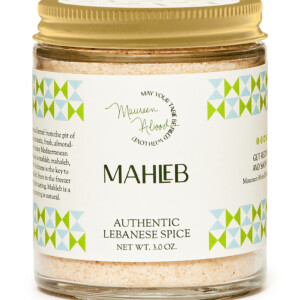
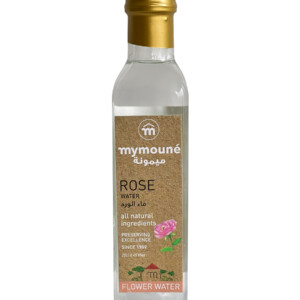
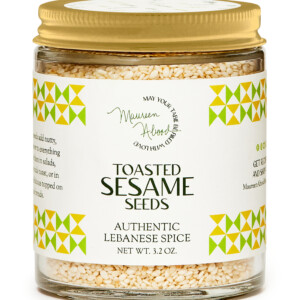
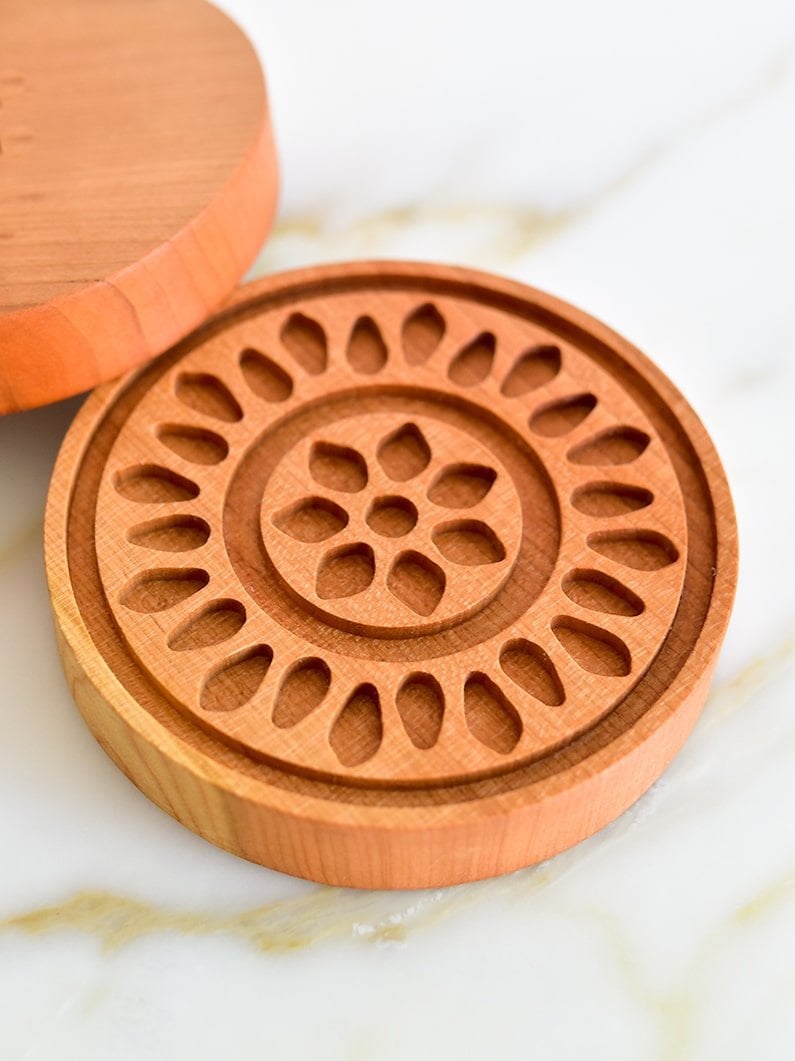
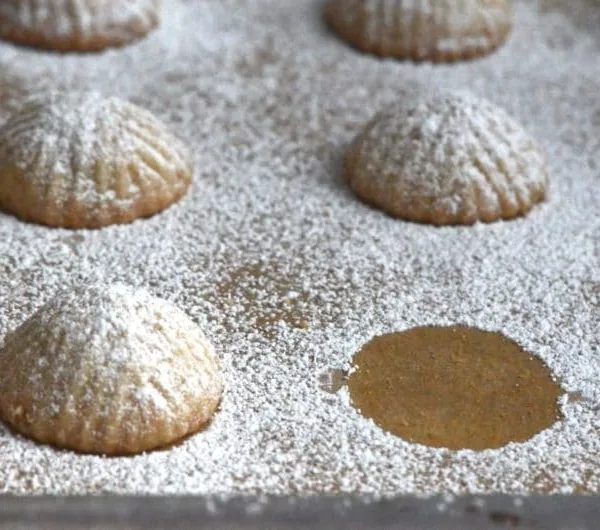
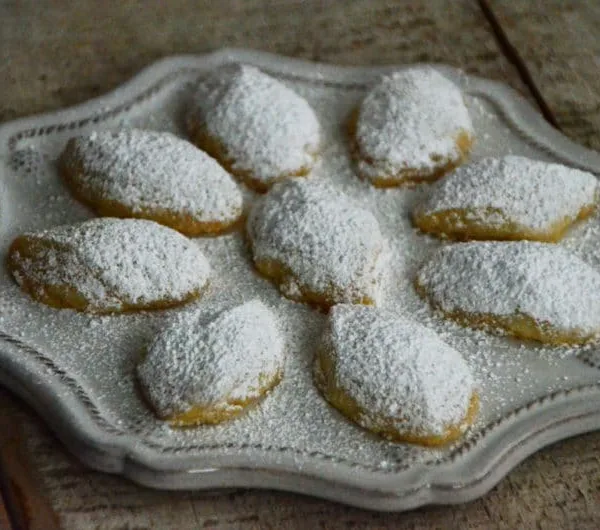
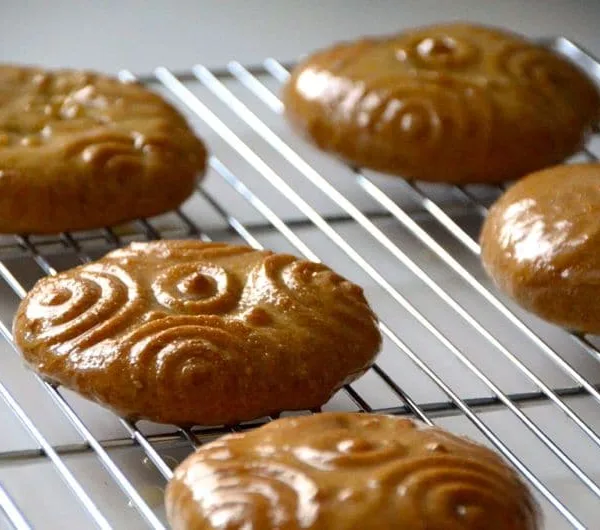
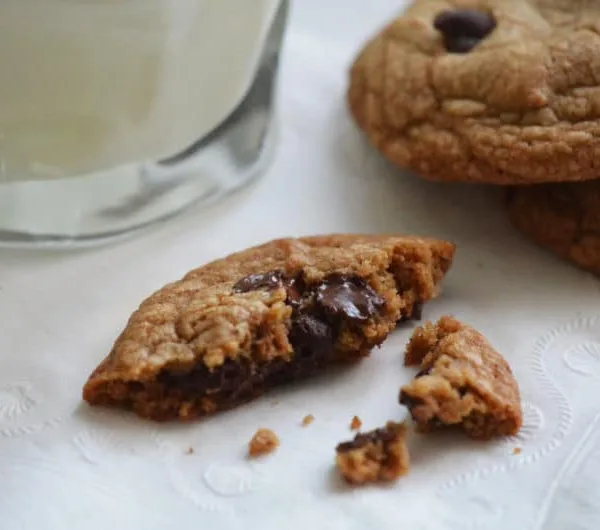







As you say, Maureen, “We know what they knew, that our baking is as much about the experience as it is the end result”. I think that encapsulates so much of what goes into even everyday cooking for those of us who do indeed enjoy cooking (well, most of the time). And it speaks, too, of the love that flows from the preparer/cook into the recipe itself.
Beautiful Josephine, thank you so much. All of that love-food connection is powerful.
Hello,
Is there any way you could add the gram weights in your recipe(s). This cups and spoons business is exasperating!
Thanks you for creating and expanding on the traditional kaak version. I like mine sweet and intensely flavorful too. Just having a difficult time with the measurements.
Thank you for your suggestion and I know that especially for baking it’s helpful.
Hi, Maureen. So happy to “meet” another Lebanese named Maureen! I have a similar Ka’ik recipe from my Mom and Sittie but we roll ours out into a thin log and twist the ends together into a knot and then pierce with a fork to hold, almost like a holed donut. It is then dipped in a rosewater flavored syrup. They told us it was an Easter treat so always make it at Easter. They can be either harder or softer depending on how long you let them rise. do you have a similar recipe and what do you call it? Love you website!
Hi Maureen! Great to connect, thank you! This version you’re describing is new to me but it sounds more like our zalabia (see my recipe here and in my cookbook). Love to hear if this is what you’re after.
My Sittie never used Nutmeg she always used Caraway. What do you think about adding nutmeg with the caraway. Love your recipe!!
My Sittie always used Caraway Seed instead if nutmeg. I wonder if you could do both and would the flavors work together
Interesting! I think it would taste good!
Hi Maureen! I’ve been dying to make these beautiful cookies and just wanted to verify the kosher salt measurement. It says 1/4 Tablespoon of kosher salt. So this would be 3/4 teaspoon? Just want to make sure I’m reading the recipe correctly! Thanks in advance for your response~~
Thank you so much Carolyn for catching this! Use 1/4 teaspoon, corrected.
Hello Maureen, the link for your moulds doesnt work … can u point me to one that does so i can buy some they look beautiful… thank you
Hi Shaun, thank you and find the molds here at MaureenAboodMarket.com! Very soon to be restocked!
Hi
Well I cannot wait to get into my kitchen to try your version of this cookie. In Canada for the past 30 years with no one to pass the recipe to me I will be forever grateful!!!
Easter will be different 2021 lol
Andrea
That is so great Andrea! Let us know how you like these!
Thank you Maureen, I did not second rise my dough. I will try your recipe next time and let you know how it turns out! Thanks again, John
Hi Maureen, I made my sitto’s ka’ik recipe. I kneaded it by hand for 20 minutes and then let it rise for 4 hours. I used my mold and they looked great going in the oven, coming out of the oven they lost their design and shape, rose almost 2-3 inches and looked like scones. They tasted amazing but looked ugly. Any thoughts on my mistake? Thanks In advance.
Hi John–the loss of the imprint on the dough is one of the reasons I revised my recipe, and one of the reasons I developed a shortbread version (see that one here). With the yeasted dough, you really have to push hard to get the shape, and even then you’ll find you lose at least some of it in the baking. Did you use a second rise of the dough? Try my recipe and method here and see if it comes out differently than your Sitto’s, with better shape.
I had so much fun using your mold for the Ka’ik, Maureen! And they came out beautifully using your recipe! Here alone with my husband love as we await our Orthodox Pascha Liturgy tonight! So very strange this year without all the kids and grandkids coming and going in my kitchen. I have used my mother’s recipe in past years. So similar to yours, but she would make using 10 cups and sometimes for the Church festivals a 5 lb bag of flour. She also added 2 eggs to her recipe. She would make ropes of the Dough and twist them to look like a braid then join the ends to make a wreath about the size of silver dollar— a lot of work! My daughter is anxious to taste these- she watched me making them as we FaceTimed! Christ is risen!
I imagine those wreaths were just beautiful! I love that you baked with your daughter, even from afar. Thank you Marlene, and may Easter joy be with you and your family always.
Where can I buy the mold from
Hello Mai–you’ll find the molds at MaureenAboodMarket.com here!
Hello Maureen! I have been wanting to try this recipe, but am not a fan of anise. Can I substitute something else or cute out the anise and arak?
Betty, absolutely you can just leave the anise and arak out. Add a little vanilla instead of the arak, or orange blossom water. You could add some other spices like cinnamon, ginger, clove to give a rounded spice cookie flavor!
Bless you Cuzzy! Your enhanced recipe is a HIT! I just finished baking and glazing my first batch and I can wholeheartedly attest that you nailed the POP of anise flavor we were looking for with the same yummy texture as the original. Good news- I found McCormick Pure Anise Extract at our Meijer store. The best part is the glaze, which is exactly what I’ve craved all these years. This cookie went from good to GREAT with every enhancement you made. Paul’s reaction after one bite was a resounding “Mmmmmmm, those are the best!” I couldn’t agree more.
Thank you! xo
I love this!!!! Thank you and how great that the Anise extract was available at the grocery store!!
Would love it if you would provide the original recipe…
Hi Ellis, absolutely–the recipe in my cookbook and here online is here.
Such beautiful pictures for this recipe and so many memories they evoke! You do have two beautiful mothers and what a blessing to be able to bake with them! I’m going to buy the molds from your marketplace and try this recipe for the first time. Thanks for the inspiration! ❤️
This makes me very happy cousin! Thank you and love to hear how your baking goes!
Hi Maureen!
Does this new recipe still produce a sweet bread vs a cookie? Timely posting – thanks!
Carol
Carol, these are soft little yeasted breads; they are more of a yeasted donut-style than a cookie.
Dear Maureen,I have been researching kaik recipes. With my sister for so long! My Dad’s aunt made a moist, spongy one that I long to duplicate but have had no success ! She died many years ago and. no one knew her recipe! She was fro Aita Lebanon! I am feeling better and eager to try your recipe! Blessings! Love to read your recipes!
Oh wonderful Marcia! I hope this recipe reminds you of your aunt’s. Keep me posted!
Just when I had resolved that we were going to eat all the cookies and desserts already in the freezer before I did any more baking.
Fresh is best!!!!
I’m excited to try this. If you do the overnight method do you put the dough in the refrigerator immediately after it’s mixed or does it need to sit on the counter first? Thanks!
Oh good Holly! For overnight, go direct to the refrigerator after you make the dough and be sure to cut back on the yeast. Love to hear how it goes!